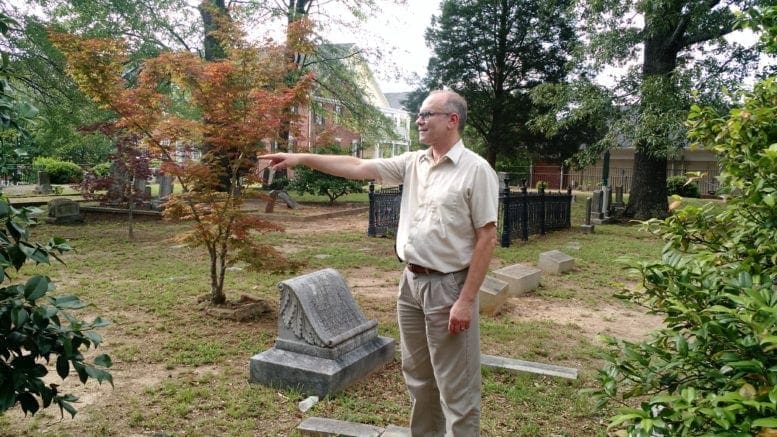Thousands of drivers pass downtown Smyrna along Atlanta Road every single day, many of them completely unaware they’re passing one of the city’s most important historic landmarks: the Smyrna Memorial Cemetery.
“I had a conversation with a couple the other day at a reception and mentioned I was working on a proposal for the Wolfe Center for a tour of the cemetery,” said William Marchione, local historian and author of the book, “A Brief History of Smyrna, Georgia.” “They had no idea where the cemetery was, and these were people who had lived in the city for nearly 30 years.”
But Smyrna Memorial Cemetery is so historic it predates the city of Smyrna itself. Smyrna was founded in the early 1800s as a Methodist campground and wasn’t incorporated until 1872. The Methodist church built and maintained the cemetery, and in the early years, it’s likely that only Methodists were buried there.
Nonetheless, many of the city’s most important pioneers are buried there, all of them facing east in accordance with Christian tradition. The earliest marked grave, Elijah Fleming, dates April 9, 1848, and the cemetery served as Smyrna’s foremost burial ground until being replaced around 1911 by the New Smyrna Cemetery on Hawthorne Avenue.
Smyrna Memorial Cemetery contains the remains of Smyrna’s first and second mayors John C. Moore (1830-1897) and Pliny Fleming (1845-1899), as well as William Bowie, who reportedly chose the name “Smyrna” for the religious campground established by the Methodists.
The burial ground is older than Atlanta’s famed Oakland Cemetery by at least two years and sat prominently near the train tracks and Smyrna train depot during the rail era. Walking around one sees the names of pioneer families repeated on the headstones: Ireland, Dunn, Fleming, Foster, Hill, Hamby, Whitfield, Ruff, Bell, Stanback and Moore to name a few.
But in Marchione’s opinion the most interesting plot by far is that of Mazie Whitfield Nelson (1890-1977), who wrote the first history of Smyrna and raised the money for the stone arch at the cemetery’s entrance.
Nelson’s mother and father, a shop owner and city councilman, are buried in the cemetery as well, and the family home is one of four facing Atlanta Road opposite the Village Green.
She was a teacher, librarian and business woman who organized field trips for the children of families who purchased insurance from her company. According to Marchione, many of Smyrna’s older residents still fondly remember the expeditions.
“She left a historical trail in stories and photographs,” Marchionne said. “Everyone seemed to know Miss Mazie.”
New burials are rare but still ongoing. For example, former Smyrna mayor Harold Smith’s wife his buried there, and Smith has a plot dedicated where he will be buried.
The Methodists deeded the property to the city in 1959, and today it still sits on prime real estate near Village Green but is obstructed from view in two ways.
One, the cemetery sits back off of Atlanta Road on a side street called Memorial Place. Two, Smyrna’s downtown redevelopment in the 1990s left the cemetery mere feet from the back walls of Corner Taqueria and Zucca Bar & Pizzeria, but with no direct access points into the development. Old gates leading to downtown were long since rendered useless by the buildings.
The cemetery features quirks that could be expected of such a historic place, and perhaps the most infamous is the story of Joe Chaney. According to the Smyrna Historical and Genealogical Society, Chaney’s arm was buried in Smyrna Memorial Cemetery after it was accidentally shot off and he visited on occasion to place flowers on its remains. When Chaney died on May 14, 1954, the rest of his body was buried about a mile away at New Smyrna Cemetery.
Also, the headstone of Nettie M. Lamb sits inside the grounds, which wouldn’t be unusual except that Lamb is buried in Cumming’s Zion Hill Cemetery nearly 50 miles away. Her actual gravesite features an updated stone with her name and dates of birth and death. No one is exactly sure what happened.
Sadly, of the roughly 600 people buried at Smyrna Memorial Cemetery, more than 300 remain unidentified.
“It may be that people in the early period couldn’t afford markers or there was perhaps no one who specialized in making them,” said Marchione. “There is another cemetery on Hawthorne Avenue which was the local black cemetery. It dates back to probably the late 1870s and there are relatively few stones there. The ones that do exist are homemade.”
Mark Cearfoss of the Cobb County Cemetery Preservation Commission has worked over the years to help document gravesites, including several at Smyrna Memorial.
“To me, every cemetery is not necessarily just a bunch of names and dates, it’s the stories that the people have to tell,” Cearfoss said. “What they went through, the challenges, the good and the bad, all of that is the story that’s important.”
Cearfoss grew up attending Smyrna First Methodist Church and still remembers cutting grass in the cemetery as a kid. He’s been interested in genealogy since his father died when he was just 14, at first tracing his own family history and then other families.
While many of the graves today sit damaged, dirty or nearly unreadable from a century of wear, Cearfoss says it’s always important to remember and respect the past.
“This is basically the founding of this community and the city of Smyrna,” said Cearfoss. “These people came here when it was all just woods and forests to blaze the way for what we have today. Too often people forget that and think we’ve always had Cumberland Mall, the Cobb Galleria and the Braves stadium. It wasn’t what we did, it’s what people have been doing for over 100 years that led to this.”

